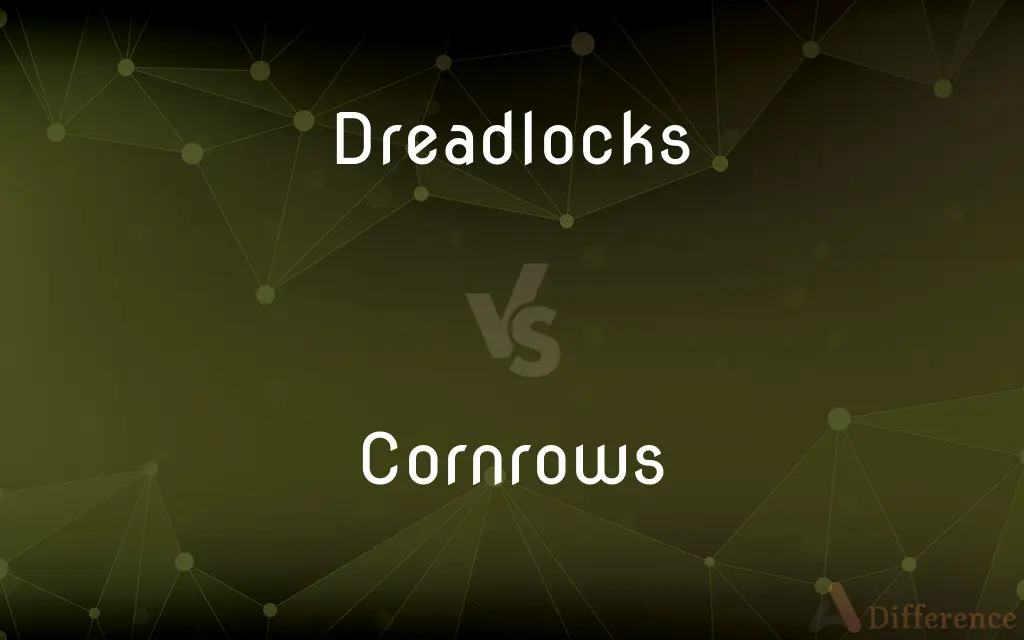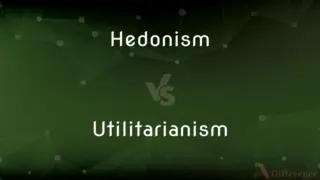Dreadlocks vs. Cornrows — What's the Difference?
Edited by Tayyaba Rehman — By Fiza Rafique — Updated on April 3, 2024
Dreadlocks are rope-like clumps of hair formed by matting or braiding, offering a low-maintenance, natural style. Cornrows are tight, close to the scalp braids that create a raised, continuous row.

Difference Between Dreadlocks and Cornrows
Table of Contents
ADVERTISEMENT
Key Differences
Dreadlocks are created by allowing hair to coil together and mat over a period, which can be a natural process or achieved through techniques like backcombing. Whereas, cornrows are achieved by braiding the hair very close to the scalp in a continuous, straight, or curved pattern to form rows.
Dreadlocks can vary in size, length, and thickness and once formed, require minimal day-to-day maintenance. On the other hand, cornrows demand regular upkeep to maintain the neatness of the rows and need to be redone periodically to manage new hair growth.
The origins of dreadlocks are widespread, with significant historical and cultural roots in Africa, India, and the Rastafarian movement, symbolizing spiritual convictions or ethnic pride. Cornrows, while also originating from Africa, were traditionally a means to convey social status, age, religion, and kinship.
Wearing dreadlocks can be a long-term commitment or lifestyle choice due to the time it takes for the hair to naturally lock and the difficulty in removing them without cutting. Cornrows offer more flexibility, allowing wearers to change their hairstyles more frequently.
Dreadlocks are often seen as a symbol of rebellion, freedom, and non-conformity in various cultures. Cornrows, while versatile in styling, have also been subject to cultural appropriation debates, highlighting the importance of understanding and respecting the origins and significance of these hairstyles.
ADVERTISEMENT
Comparison Chart
Formation
Matting or braiding hair into rope-like clumps.
Braiding hair close to the scalp in straight or curved rows.
Maintenance
Low day-to-day maintenance, but can be difficult to completely remove.
Requires regular upkeep and re-braiding to manage new growth.
Cultural Significance
Symbolic in various cultures, often representing spiritual or ethnic pride.
Originated in Africa as a means to convey social status, age, religion, and kinship.
Flexibility
Less flexible, often a long-term commitment due to the matting process.
More flexible, allowing for frequent changes in hairstyle.
Symbolism
Associated with rebellion, freedom, and non-conformity.
Versatile, but its appropriation has sparked cultural debates.
Compare with Definitions
Dreadlocks
Symbolic of rebellion and freedom in some cultures.
His dreadlocks are a symbol of his spiritual journey.
Cornrows
Require regular maintenance to stay neat.
She gets her cornrows redone every few weeks to maintain their appearance.
Dreadlocks
Rope-like strands of hair formed by matting or braiding.
Bob Marley popularized dreadlocks as part of his Rastafarian beliefs.
Cornrows
Have cultural and historical significance, especially in African communities.
Cornrows are not just a style but a part of her heritage.
Dreadlocks
Can be worn by all hair types but varies in texture and thickness.
Her dreadlocks have matured beautifully over the years.
Cornrows
Tight, scalp-hugging braids in straight or curved rows.
Serena Williams often sports cornrows on and off the tennis court.
Dreadlocks
A hairstyle with minimal daily upkeep but difficult to remove.
She chose dreadlocks for their easy maintenance.
Cornrows
A versatile hairstyle allowing for various patterns.
His cornrows are braided into an intricate design.
Dreadlocks
Historically significant in many cultures around the world.
Dreadlocks have been worn for centuries in various African tribes.
Cornrows
Subject to cultural appropriation debates.
The fashion industry has been criticized for appropriating cornrows without acknowledging their origins.
Dreadlocks
Dreadlocks, also locs, dreads, or in Sanskrit, Jaṭā, are rope-like strands of hair formed by locking or braiding hair.Dreadlocks are controversial and commonly a flashpoint of cultural appropriation, but the style is demonstrably global and ancient and multicultural. Even the name is controversial, having negative and colonial connotations.
Cornrows
Cornrows or canerows are a traditional style of braids in which the hair is braided very close to the scalp, using an underhand, upward motion to make a continuous, raised row. Cornrows are often done in simple, straight lines, as the term implies, but they can also be styled in elaborate geometric or curvilinear designs.
Dreadlocks
A hairstyle worn by Rastafarians and others in which the hair is left to grow into long matted strings.
Cornrows
To arrange or style (hair) by dividing into sections and braiding close to the scalp in rows.
Cornrows
Plural of cornrow
Common Curiosities
What do dreadlocks symbolize?
They can symbolize spiritual convictions, rebellion, or ethnic pride, depending on the cultural context.
Do dreadlocks require a lot of maintenance?
They require minimal day-to-day maintenance but are difficult to remove.
What are dreadlocks?
Rope-like clumps of hair formed by matting or braiding.
How are dreadlocks formed?
Through natural matting of hair or intentional techniques like backcombing.
What are cornrows?
Tight, scalp-hugging braids that form straight or curved rows.
Can anyone wear dreadlocks?
Yes, people of all hair types can form dreadlocks.
Why are cornrows culturally significant?
They have deep roots in African history, used to convey social and religious statuses.
How often do cornrows need to be redone?
To maintain neatness, they should be redone periodically as new hair grows.
Are cornrows flexible in styling?
Yes, they allow for a wide range of patterns and designs.
Who can wear cornrows?
While anyone can wear them, it's important to understand and respect their cultural significance.
Share Your Discovery

Previous Comparison
Hedonism vs. Utilitarianism
Next Comparison
Wordmark vs. TrademarkAuthor Spotlight
Written by
Fiza RafiqueFiza Rafique is a skilled content writer at AskDifference.com, where she meticulously refines and enhances written pieces. Drawing from her vast editorial expertise, Fiza ensures clarity, accuracy, and precision in every article. Passionate about language, she continually seeks to elevate the quality of content for readers worldwide.
Edited by
Tayyaba RehmanTayyaba Rehman is a distinguished writer, currently serving as a primary contributor to askdifference.com. As a researcher in semantics and etymology, Tayyaba's passion for the complexity of languages and their distinctions has found a perfect home on the platform. Tayyaba delves into the intricacies of language, distinguishing between commonly confused words and phrases, thereby providing clarity for readers worldwide.
















































